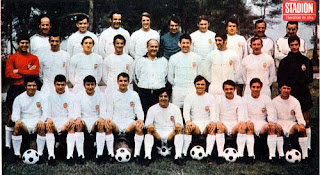Holland illustrated well the most of Europe: domestic leagues usually dominated by two or three traditionally strong clubs year after year. In this realm new football was an empty dream. Yet, smaller championships had bigger charm in the early 1970s than in 21st century: they were relatively similar around Europe. A talented generation of a club or a national team elevated a country above others for awhile, thus making European tournaments less predictable than now. 1971 looked like restoration of the status quo in USSR, for example. CSKA, the champions of 1970, were nowhere to be seen. Dinamo (Kiev) were champions once again.

Soviet clubs often posed in civilian cloths – such pictures were perhaps the most striking difference between Communist world and the West: the Easterners looked pathetic.
First row, left to right: V. Terentiev – director of the team, V. Khmelnitzky, V. Veremeev, V. Troshkin, S. Dotzenko, A. Bogovik
Middle: V. Kolotov, E. Rudakov, V. Sosnikhin, P. Feldstein – administrator, V. Muntyan
Top: V. Matvienko, S. Reshko, F. Medvid, A. Puzach, A. Byshovetz, R. Zhuravsky, A. Sevidov – coach, M. Koman – assistant coach. Although 7 players of this squad concurred Europe four years later, this was a team in transition – old guard slowly stepping down and new ones not yet established firmly. But the Ukrainians already established themselves as a constant power during the 1960s and obviously had no intention to fade away in the 1970s. Note Byshovetz – leading Russian coach in the 1990s.
First row, left to right: V. Terentiev – director of the team, V. Khmelnitzky, V. Veremeev, V. Troshkin, S. Dotzenko, A. Bogovik
Middle: V. Kolotov, E. Rudakov, V. Sosnikhin, P. Feldstein – administrator, V. Muntyan
Top: V. Matvienko, S. Reshko, F. Medvid, A. Puzach, A. Byshovetz, R. Zhuravsky, A. Sevidov – coach, M. Koman – assistant coach. Although 7 players of this squad concurred Europe four years later, this was a team in transition – old guard slowly stepping down and new ones not yet established firmly. But the Ukrainians already established themselves as a constant power during the 1960s and obviously had no intention to fade away in the 1970s. Note Byshovetz – leading Russian coach in the 1990s.












 Thanks to Igor Nedbaylo for the photo of CFV!
Thanks to Igor Nedbaylo for the photo of CFV!








